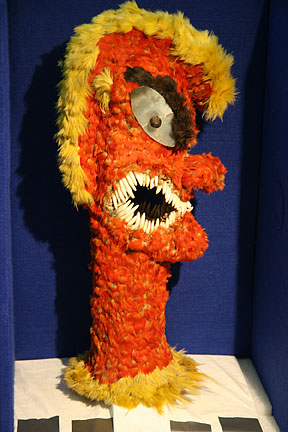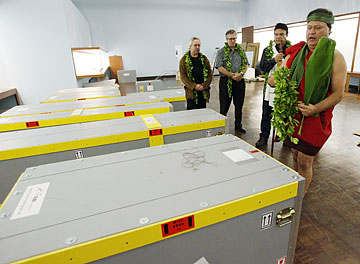The "Life in the Pacific of the 1700s: The Cook/Forster Collection of the Georg August University of Göttingen"

STAR-BULLETIN PHOTO ILLUSTRATION
The feathered Kuka'ilimoku included in the exhibit (pictured below) is believed to be a gift given to Capt. James Cook when he arrived on the Big Island in 1779.
|
|
Voyage to the past
Artifacts collected by Capt. James Cook on his Pacific voyages will be on display here
A RARE, pristine collection that includes Hawaiian artifacts given to British navigator Capt. James Cook during his voyages to the Pacific more than 225 years ago will be displayed for the first time in a public museum at the Honolulu Academy of Arts this week.
The "Life in the Pacific of the 1700s: The Cook/Forster Collection of the Georg August University of Göttingen" will feature 350 artifacts at the museum from Thursday through May 14.

CRAIG T. KOJIMA / CKOJIMA@STARBULLETIN.COM
The ki'i hulu manu is a feathered image of Kuka'ilimoku, the deity of war and healing.
ARTIFACTS ON EXHIBIT
The "Life in the Pacific of the 1700s: The Cook/Forster Collection of the Georg August University of Göttingen" exhibit will be displayed at the Honolulu Academy of Arts, 900 S. Beretania St. from Thursday through May 14.
» Public viewing hours are Tuesday through Saturday from 10 a.m. to 4:30 p.m. and Sunday from 1 to 5 p.m. On March 19 and April 9, the museum will extend their Sunday hours from 11 a.m. to 5 p.m. The museum is closed on Mondays; however, school groups will be able to view the exhibit on Mondays if prior reservations are made.
» Lectures and films relating to the collection and the Pacific will also be held.
» Admission to the museum is free from Thursday through May. 14.
For more information, call the Honolulu Academy of Arts at 532-8701 or visit www.honoluluacademy.org.
|
|
Stephen Little, director of the Honolulu Academy of Arts, said he decided to waive admission fees so the public can have a chance to view the largest collection at the museum.
"We're really honored to have the opportunity to be the host of the these rare, powerful objects," he said.
One of the most sacred artifacts is the ki'i hulu manu, a feathered image of Kuka'ilimoku, the deity of war and healing. Little said an alii from the Big Island gave the ki'i hulu manu to Cook as a gift when he arrived on the Big Island in 1779. It has mana (spiritual power), he said.
The vibrant bird feathers have been so well-preserved, like most of the artifacts in the collection, that it looks as if it were created yesterday, Little said. The artifact is also made with dogs' teeth, mother-of-pearl and wicker.
The artifacts in the collection were given to Cook from indigenous people as a gift or in trade during his second and third expeditions to the Pacific between 1768 and 1779. Cook was killed on Feb. 14, 1779, at Kealakekua Bay on the Big Island.
Thirty-five artifacts in the collection are from Hawaii, representing a small part of the vast exhibit. Most are from Tonga, Tahiti and New Zealand, Little said.
Another significant artifact is a heva, a mourning dress from Tahiti. Other artifacts include weapons and musical instruments from Tonga; kapa from Hawaii; and fishhooks, tattoo combs, baskets and weapons from a collection owned by Johann Reinhold Forster and his son, George. Both scientists from Germany joined Cook during his second expedition to the Pacific.
About 500 artifacts from Cook's voyages were donated by England's King George III to the academic museum of the Georg August University in 1782.
Little learned of the collection from Peter Ruthenberg, a native of Germany who now lives on Maui. Ruthenberg approached him two years ago with a book written by Brigitta Hauser-Schäublin and Gundolf Krüger, which focused on the collection. Little said he was unaware the collection existed.
Little, with the help of Ruthenberg, got in contact with officials in Germany and later traveled to the country to ask the administrator of the university's Institute of Cultural and Social Anthropology -- where they kept the artifacts well-preserved for more than 200 years -- permission if he could display the collection at the Honolulu Academy of Arts. The administrator agreed.

GEORGE F. LEE / GLEE@STARBULLETIN.COM
Following brief ceremonies earlier this month, Tony Lenchanko, right, placed a lei on a crate of recently arrived Hawaiian artifacts at the Honolulu Academy of Arts on Friday. Exhibition shipper Ernst Fuchs, Academy of Arts Director Stephen Little and La'akea Suganuma, president of the Royal Hawaiian Academy of Traditional Arts, looked on.
|
|
Little also consulted with several cultural experts such as La'akea Suganuma, president of the Royal Hawaiian Academy of Traditional Arts, and kumu hula John Keola Lake to get their feedback on whether the artifacts should be displayed at the museum at a time when controversy surrounds 83 artifacts that were reburied in two caves on the Big Island.
After all these years, the artifacts survived its travel over the Pacific and wars, Suganuma said. They are being allowed to return for a period for viewers to respect and appreciate, he added.
"This was meant to be and it was meant to come here at this time when there is so much controversy about Hawaiian artifacts," said Suganuma, who recently traveled to Germany with other members of the Royal Hawaiian Academy to bless and escort the collection to Hawaii.
Suganuma is one of the claimants who filed a federal lawsuit against Hui Malama I Na Kupuna 'O Hawai'i Nei, an organization that reburied 83 artifacts in two caves on the Big Island. All parties are involved in mediation to resolve the dispute.
"We have a controversy where people want to bury everything," Suganuma said.
Little said the entire collection will return to Germany once the exhibit ends.
Getting the collection to the islands was a large task for museum officials.
The Honolulu Academy of Arts spent about $500,000 to carefully pack and transport the entire collection. A federal grant was also obtained to insure most of the artifacts.
Little noted that one of the main reasons why he wanted the collection to be displayed was to show the connection between the cultures in the Pacific.
The purpose of this exhibit is "to celebrate the brilliant cultural and spiritual lives of the indigenous people of the Pacific as they existed prior to the first contact with Westerners," he said.

